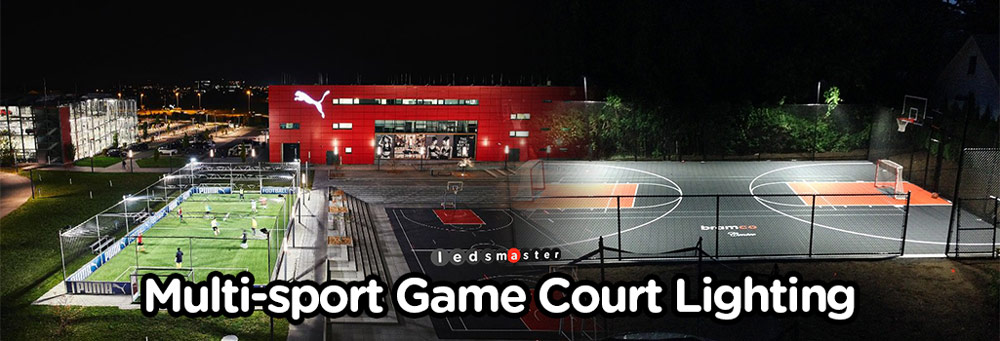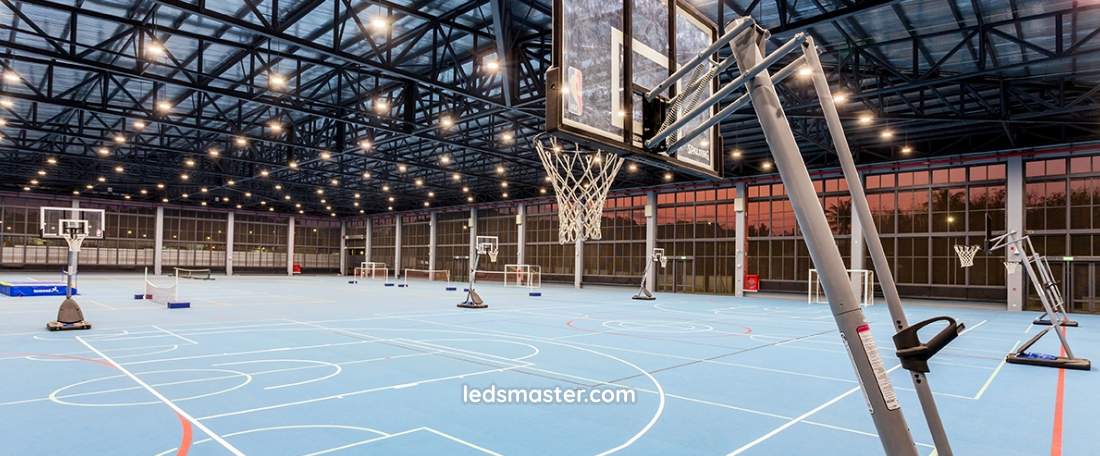Designed to meet the diverse demands of various sports, our lights blend powerful brightness, impeccable uniformity, and unmatched durability. Whether you’re hosting a community basketball tournament or professional-level volleyball matches, our cutting-edge lighting ensures crystal-clear visibility and optimal performance. Embrace the future of sports lighting and transform your court into a dynamic and vibrant arena where every play shines.
Our adaptable LED lights are designed to meet the needs of multi-sport game courts, integrating essential features such as anti-glare, high uniformity, flicker-free performance, and water resistance into a single, comprehensive luminary. By providing optimal illumination, our lights enhance both indoor and outdoor courts, making them perfect for a wide range of sports including basketball, football, badminton, hockey, volleyball, tennis, and more.
We understand that each multi-functional sports pitch has unique lighting requirements based on its layout and size. That’s why we offer tailored lighting solutions to ensure that every court benefits from precise, effective illumination.
Upgrading to LED lighting from traditional sources like metal halide, mercury vapor, and HPS significantly reduces energy consumption and maintenance needs. Discover how our LED multi-game court lights can transform your sports facilities.
Get your complimentary lighting design today
Table of Contents
ToggleEffective lighting design begins with a clear understanding of the lighting needs for your multi-functional sports court. To achieve optimal results, consider the following key factors:
Determining the appropriate brightness level for a multi-game sports field is essential to ensuring optimal performance and enjoyment. For residential or recreational settings, a lighting level of 200 to 300 lux is typically adequate. This range of illumination provides a comfortable and pleasant environment for players, making it suitable for casual games and everyday use. Lux, which measures the illuminance of the ground, reflects how well the surface is lit and how effectively the light is distributed. In this range, the lighting is bright enough to allow players to see clearly without creating excessive glare or harsh shadows, which contributes to a more enjoyable and relaxed playing experience.
On the other hand, commercial multi-sport courts have more demanding lighting requirements. Here, a brightness level of 500 to 700 lux is often necessary. This higher level of illumination not only meets the needs of more intense and competitive play but also enhances the visibility for activities such as video recording. Adequate lighting in this range ensures that the playing surface is evenly illuminated, which is crucial for high-quality video footage and for creating an environment that supports professional-level play. The increased brightness helps to create a vibrant and dynamic atmosphere, making the sports facility more appealing for players, spectators, and media coverage alike.

Uniform light distribution is a critical aspect of effective sports lighting, extending beyond mere brightness to ensure an optimal playing environment. Uniform lighting means that the light is evenly spread across the playing surface without significant variations in intensity. This consistency is essential for a number of reasons.
First and foremost, uniform lighting significantly enhances the visibility of all elements on the court. Players need to clearly see their opponents, the ball, and the contours of the playing surface to perform at their best. Inconsistent lighting can create shadows, bright spots, or areas of darkness that can obstruct vision and interfere with gameplay. This can be particularly problematic in fast-paced sports where quick reflexes and precise actions are crucial.
For training purposes, achieving a lighting uniformity of around 0.5 is considered ideal. Uniformity in this context refers to the ratio of the minimum to the maximum illumination level across the court. A ratio of 0.5 indicates that the light distribution is sufficiently even to avoid any significant disparities in lighting intensity. This level of uniformity ensures that all areas of the playing surface are lit consistently, providing a fair and clear view for all players.

For lights mounted on outdoor high-mast poles, waterproofing is a critical consideration. Outdoor environments expose lighting fixtures to various weather conditions, including rain, snow, and humidity. To ensure longevity and reliable performance, it is essential that the lighting fixtures are adequately protected against these elements.
Our LED lights are designed with an IP66 rating, which signifies superior resistance to both dust and water. An IP66 rating means that the lights are completely dust-tight and can withstand powerful water jets from any direction without compromising functionality. This level of protection is particularly important for outdoor high-mast lighting, which is often exposed to severe weather conditions. Whether it’s heavy rain or a snowstorm, our LED lights maintain their performance and durability, ensuring that they continue to provide consistent illumination without the risk of water damage.
The robust waterproofing features of our lights not only extend their lifespan but also reduce maintenance needs. By preventing water ingress, we eliminate the risk of electrical faults and corrosion, which can otherwise lead to frequent repairs or replacements. This makes our LED lighting solutions an ideal choice for outdoor sports facilities where reliable and uninterrupted lighting is essential for both safety and performance.
The lifespan of lighting fixtures is a crucial factor, especially when considering the high costs associated with installation. Traditional lighting options such as metal halide or fluorescent lights typically offer a service life ranging from 5,000 to 10,000 hours. While these figures might seem adequate at first glance, they translate to more frequent replacements and higher long-term maintenance costs.
In contrast, our LED flood lamps are engineered for exceptional longevity, boasting an impressive 120,000-hour lifespan. This duration is equivalent to approximately 41 years of use, assuming 8 hours of operation per day. This extended lifespan is a significant advantage, as it translates to fewer replacements and reduced maintenance expenses over time.
The extended life of our LEDs means that once installed, they will provide consistent, high-quality lighting for many years. This durability is a key benefit for facilities looking to make a long-term investment in their lighting infrastructure. The reduced need for frequent bulb changes and the associated labor costs contribute to substantial savings, making our LED lights not only a cost-effective solution but also a smart investment for the future.
In sports facilities, where fast-moving balls and equipment can occasionally strike the lighting fixtures, impact resistance is a vital feature. Traditional lighting options, such as metal halide lights, often come with large, fragile glass covers that are susceptible to damage from impacts. This vulnerability can lead to costly repairs or replacements and poses a risk to both the safety and functionality of the lighting system.
Our LED lights are designed with robust polycarbonate lens covers that offer superior impact resistance. Unlike glass, polycarbonate is a durable and flexible material that can withstand significant force without shattering. This resilience is particularly important in environments where sports equipment like tennis rackets, baseballs, or soccer balls might come into contact with the lights.
The impact-resistant design of our LEDs ensures that they can endure the rigors of an active sports environment, maintaining their performance and safety even under challenging conditions. This not only enhances the durability of the lighting system but also contributes to the overall safety of the facility by reducing the risk of broken glass and potential injuries. By choosing our LED lights, you can be confident that your lighting fixtures are well-protected against accidental impacts, providing reliable and long-lasting illumination.
Energy efficiency is a critical consideration for indoor sports centers due to the substantial impact it has on operational costs and player comfort. In lighting systems, energy efficiency refers to how effectively the lighting technology converts electrical energy into visible light.
LED lights are renowned for their exceptional energy efficiency. They convert between 90 to 95% of the electrical energy they consume directly into light. This high conversion rate means that a minimal amount of energy is wasted as heat. For indoor sports centers, where lighting is used extensively, this efficiency translates into significant cost savings. By utilizing LEDs, facilities can achieve the same or even superior lighting levels while consuming far less electricity compared to traditional lighting technologies.
In contrast, halogen bulbs, which are a common alternative, exhibit much lower energy efficiency. They convert only 5 to 10% of the input energy into light, with the remaining 90 to 95% dissipated as heat. This inefficiency has several implications for indoor sports centers. The excess heat generated by halogen bulbs can lead to elevated room temperatures, creating an uncomfortable environment for both players and spectators. Higher temperatures may also necessitate increased use of air conditioning systems to maintain a comfortable climate, further driving up energy costs.
The reduced heat output of LED lights addresses this issue effectively. LEDs emit minimal heat compared to halogen bulbs, converting the majority of the energy into light rather than thermal energy. This characteristic helps to keep the ambient temperature within the sports center cooler. Lower room temperatures not only enhance the comfort of athletes during intense physical activities but also reduce the load on air conditioning systems. As a result, facilities can experience lower cooling costs, making LEDs a more economical and comfortable choice.
A well-designed lighting system not only enhances visibility and safety but also adapts to the diverse needs of different sports, ensuring that every game is played under optimal conditions. By considering factors such as uniform illumination, adjustable lighting levels, and energy efficiency, facility managers can provide a dynamic and high-quality playing experience.